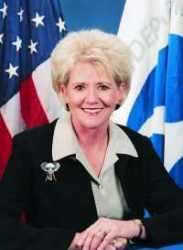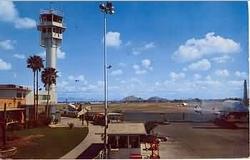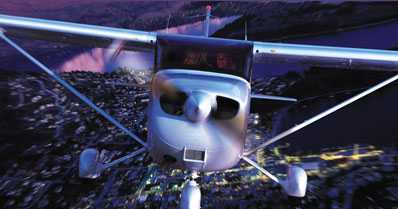Says Upcoming FAA Reauthorization "One Chance To Get It
Right"
 Editor's Note:
Below is the unedited text of a speech given by Transportation
Secretary Mary Peters Tuesday, before the Aero-Club of
Washington.
Editor's Note:
Below is the unedited text of a speech given by Transportation
Secretary Mary Peters Tuesday, before the Aero-Club of
Washington.
In the speech, Peters says the upcoming expiration of the
FAA authorization and Trust Fund "provides a once-in-a-decade
opportunity to rewrite the book when it comes to America’s
aviation policies"... before adding "the FAA needs a new funding
mechanism, and ... we must have incentives in place that will make
the system more efficient as well as more responsive to user
needs."
With details of that plan expected to be released very
shortly... the tone of Secretary Peters' speech seems to indicate
user fees are what the FAA and DOT have in mind...
Thank you so much, Debby (McElroy), for that very kind
introduction. And Paula (Hochstetler), congratulations on your
election as the Aero Club’s new president.
I would also like to recognize some key members of the
Department of Transportation’s leadership team who are here
this afternoon: Deputy Secretary Maria Cino, Under Secretary for
Policy Jeff Shane, Federal Aviation Administrator Marion Blakey,
and Assistant Secretary for Aviation and International Affairs Andy
Steinberg.
And thank you all for that absolutely wonderful welcome. Let me
tell you what a thrill it is to address the Aero Club and lay out
the Bush Administration’s aviation agenda for the next two
years – an aggressive agenda that includes getting our
framework right at home and expanding opportunities abroad.
I only wish that my mother could be here! You see, it was my
mother who instilled a deep-seeded reverence for flying in me from
earliest childhood. She was then, and until the day she died, a
huge fan of aviation. For many years, she worked for the Director
of the California Department of Aeronautics.
And when I was growing up in Phoenix, we celebrated birthdays
with a trip to her favorite place – Sky Harbor Airport. It
was always a special treat. I remember we would get sparklers
instead of candles on the cake. And best of all, we would watch the
planes as they arrived in Phoenix, and as they whisked their
passengers off to exciting destinations.
 Earlier this month, I
was back at Sky Harbor, this time to open a new, state-of-the-art
air traffic control tower. It is one of many facility, equipment
and procedural improvements scheduled for airports around the
country this year to make flying safer and more
efficient.
Earlier this month, I
was back at Sky Harbor, this time to open a new, state-of-the-art
air traffic control tower. It is one of many facility, equipment
and procedural improvements scheduled for airports around the
country this year to make flying safer and more
efficient.
Sky Harbor has come a long way from the sleepy little small-town
airport I grew up with. Today, it handles more than a half million
take-offs and landings each year. And that number is projected to
almost double by 2025.
We are seeing similar growth across the country and around the
world.
In 2005, nearly 750 million passengers flew on U.S. commercial
flights. And we are racing toward 1 billion passengers by 2015
– less than a decade from now.
Meanwhile, companies like Cessna and Eclipse are preparing
delivery of thousands of new very light jets, with the potential to
usher in the largest increase in air traffic since the
1960s.
President Bush summed up the challenge we face simply and
succinctly during my swearing in as Secretary of Transportation:
our nation is outgrowing its aviation capacity. And I have promised
the President that we are going to tackle this challenge head-on by
applying 21st Century solutions to safely meet the fast-growing
demands on our aviation network.
Let me stress that safety tops my list of priorities for
transportation, and aviation is no exception.
Even with the commendable progress Administrator Blakey and her
team have achieved, last year’s crash in Lexington and the
recent runway incursion in Denver underscore why we must always
keep pushing the envelope to make air travel safer. That is why we
must, for example, take full advantage of the latest
satellite-based technologies that enable aircraft to fly with much
greater precision, improving safety in congested airspace.
And without compromising safety, we have got to continue
pursuing new ways to squeeze every ounce of capacity possible out
of our existing facilities and airspace by improving system
performance.
We have had successes with the new reduced vertical separation
rules and the Airspace Flow Program that proved so effective in
reducing delays this summer and again during the holidays. And the
new precision runway monitoring system that we are commissioning
this year at Atlanta-Hartsfield is going to allow up to 23
additional aircraft an hour to land at the airport.
Perhaps most important of all, as we tackle these and other
challenges, we need to be forward-looking, rather than clinging to
the policies and ways of the past.
It is not just a matter of new technology, or even the
transformational NextGen initiative announced at this forum three
years ago. To give America an aviation system capable of keeping up
with demand that is changing radically and growing exponentially
– rather than one that is mired in gridlock – we must
move the system away from its 1950s architecture.
We must retool and rethink our policies, and our financing, to
bring them into the 21st Century by embracing innovation and
acknowledging the critical role the private-sector can have in
building and operating aviation infrastructure.
And, most of important of all, we must treat our aviation
network for what it is – a tremendous national economic asset
that, like all our transportation networks, must perform
efficiently in order to support the broader economy.
This isn’t pie-in-the-sky thinking. It is a response to
the changes we see all around us. It is the philosophy behind
the Department’s Congestion Initiative, announced last May.
And it is the thinking we need to inject into our aviation
system.
And this is the year to do it.
I want to stress how critically important 2007 is for aviation.
Expiration of the FAA authorization and Trust Fund financing
provides a once-in-a-decade opportunity to rewrite the book when it
comes to America’s aviation policies. And I believe that we
will have failed both the industry and the American people if we do
anything less.
The importance of getting a financing bill that ties revenues to
costs and allows us to manage the FAA more efficiently cannot be
overstated. This is our one chance to get it right. Our goal is to
have the Administration’s bill out shortly after the
President’s budget submission. And I look forward to working
with the Congress – and with all of you – to make this
measure happen.
In fact, I have already opened up a dialogue with the new
Chairmen and ranking members of the Transportation Committees and
Aviation Subcommittees. They are equally anxious to move forward on
a ground-breaking bill.

I have also spent a lot of time with leaders across the aviation
spectrum, including many of you in this room.
I have traveled around the country to talk with the craftsmen
who are filling the growing orders for new jet airliners and the
visionaries who are designing tomorrow’s revolutionary new
aircraft.
I have joined the men and women who see that the increasing
volumes of goods shipped by air arrive at their destinations on
time and the new controllers we are training to guide the expanding
volume of air traffic safely through crowded skies.
I have sat down with airport and airline executives, with
commercial pilots, and with representatives of the general aviation
community.
I have observed that, like my mother, just about everyone
involved with aviation is passionate about what they do.
Now, I want to ask you to focus that passion beyond your
individual special interests to the broader challenges facing
aviation and the nation. I know that user fees and who pays are big
concerns for many of you, but we must not lose sight of the broader
issues at stake.
What we need to focus on is how best to lay the groundwork for
the system of tomorrow – the system of the next
generation.
We are talking about a fundamental redesign of the entire air
transportation system.
But it won't happen overnight, and it won't come for free.
 That is why the FAA
needs a new funding mechanism, and why we must have incentives in
place that will make the system more efficient as well as more
responsive to user needs.
That is why the FAA
needs a new funding mechanism, and why we must have incentives in
place that will make the system more efficient as well as more
responsive to user needs.
Believe me, if we don't get this right, we will all pay as
congestion overwhelms the system. There will be no “just in
time” deliveries of parts and resources using air freight;
home for the holidays will be a travel nightmare, at best; and
forget about last-minute packages.
If we continue along the current path, estimates are that, by
2022, congestion across our skies will cost this nation $22 billion
each year in lost economic activity.
That is not a future that any of us want. Nor is it
inevitable.
Aviation today contributes $640 billion dollars a year to the
American economy. That is 5.4 percent of U.S. GDP, and it accounts
for over 9 million jobs. And by aligning our funding mechanisms and
programs to be responsive and meet contemporary challenges, we can
ensure that aviation will be an even more dynamic force in the
economy of the future.
I know you all are looking forward to the specifics of our
proposal, and I look forward to sharing them with you very
soon.
In the meantime, like our agenda here at home, our international
agenda focuses on putting the foundations in place to build a
stronger industry that can continue to be a driver of growth both
for our national economy, and for local communities.
Aviation has benefited from President Bush’s successful
effort to promote strong economic growth for our nation.
Particularly key to helping U.S. aviation regain its footing
– even while dealing with such uncontrollable factors as
volatile oil prices – has been the Administration’s
focus on expanding trade and opening markets to American goods and
services.
Secretary Mineta left some big shoes to fill in a variety of
areas, nowhere more so than when it comes to opening up
international aviation markets.
Over the past six years, we’ve welcomed 25 new open skies
partners, and significantly opened up China’s restrictive
market. In fact, just this month we issued a preliminary decision
for another new route under the landmark aviation agreement
negotiated with China in 2004. Wall Street estimates place the
direct value of this route at anywhere from $50 million to $300
million a year.
And overall, the total economic impact of the additional U.S.
cargo and passenger carrier routes during the first seven years of
the China agreement is expected to be $12 billion, according to
internal DOT projections.
I am very excited about opening markets and what it can mean for
businesses in this country and for our economy. A recent study
found that, on average, air traffic grows anywhere from two to four
times faster where air service agreements are liberalized. The
result, in addition to bringing Americans more flight and travel
options, is greater opportunity for economic development spurred by
the aviation industry within the U.S., and abroad.
The agreements we are pursuing will assist U.S. carriers in
expanding and solidifying their business position, as well as
expanding markets for our aircraft and technology. And looking
ahead, we have identified several major opportunities to open new
markets for our airlines and other aviation businesses and their
employees, as well as create better travel options for
Americans.
The first is in our own backyard. Mexico and Canada are not only
our closest neighbors, they are also our top trading partners.
Transportation is key to keeping this robust flow of trade
thriving. And today, I am announcing a North American
transportation summit to explore ways to improve the movement of
people and goods across our common borders.
I am inviting the ministers of transport from Canada and Mexico
to join me in Tucson, Arizona, in March. This will be the first
time North American transportation ministers will come together in
a trilateral meeting. And it represents a tremendous opportunity to
expand on our progress in opening markets for U.S. airlines and
other transportation concerns that can keep these large and growing
volumes of goods and travelers moving efficiently across our common
borders.
Looking further south, we are planning a major mission to Latin
America to help our transportation firms participate in these
growing markets.
And building on our growing aviation relationship with China, I
plan to participate in the China Strategic Economic Dialogue (SED)
here in Washington this May. Aviation will be on the agenda. China
represents a huge market for all kinds of transportation interests.
So, in addition to the economic dialogue effort, I plan to travel
to Shanghai and Beijing in April. A major focus of this mission
will be opening doors for U.S. transportation companies to compete
in that rapidly developing market. We will be building on the
progress that industry – along with the FAA and the U.S.
Trade and Development Agency – is making in the technical
arena through the Aviation Cooperation Program. I know many of you
here are participants in and supporters of that process.
And we have not given up on Europe. It is too important to walk
away from the table. Indeed, I hold high hopes that we will
find common ground and be able to sign an agreement with the EU
before my tenure as Secretary ends.

I am looking forward to the next two years. The challenges ahead
are great, but the opportunities are greater.
My goal is to put the foundation in place that will keep America
flying high through aviation’s second century.
I will be driving hard to see that, this year, we do more than
re-authorize aviation programs and instead revitalize them to fit
the 21st Century.
And I will be pushing for open skies and open opportunities for
America’s aviation businesses, because opening markets is the
gateway to a stronger industry, a stronger economy, and more
aviation jobs on the ground and in the air.
I look forward to working with you to accomplish these goals.
Thank you for being here.
 ANN's Daily Aero-Linx (04.16.24)
ANN's Daily Aero-Linx (04.16.24) Aero-News: Quote of the Day (04.16.24)
Aero-News: Quote of the Day (04.16.24) Airborne 04.10.24: SnF24!, A50 Heritage Reveal, HeliCycle!, Montaer MC-01
Airborne 04.10.24: SnF24!, A50 Heritage Reveal, HeliCycle!, Montaer MC-01 Airborne 04.12.24: SnF24!, G100UL Is Here, Holy Micro, Plane Tags
Airborne 04.12.24: SnF24!, G100UL Is Here, Holy Micro, Plane Tags Airborne-Flight Training 04.17.24: Feds Need Controllers, Spirit Delay, Redbird
Airborne-Flight Training 04.17.24: Feds Need Controllers, Spirit Delay, Redbird







